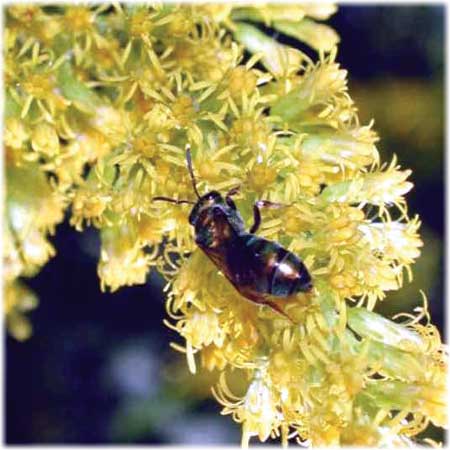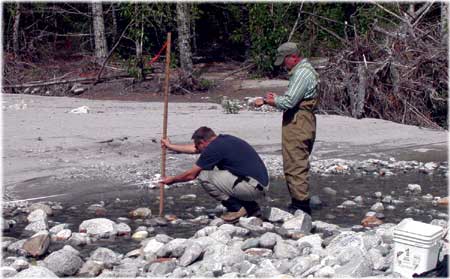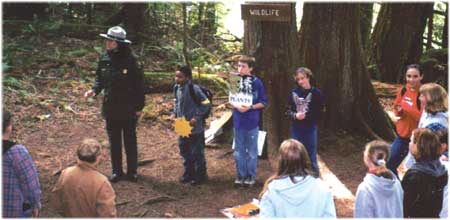|
WHAT'S NEXT?
Possible Future Research Projects
Along with ongoing research and
monitoring, North Cascades National Park Resource Managers are always
thinking about the next step. What starts as a general area of study,
becomes a research question and eventually turns into a plan to study
specific natural resources. The following are two projects to look at
the status of resources for which there is limited information. These
studies could begin within the next few years.
Status and Distribution of the Marbled
Murrelet
North Cascades National Park is a last
chance habitat for a handful of federally listed animal species. Of
these species, the Marbled Murrelet is one for which baseline
inventories have not been conducted to determine the presence and status
of the species within the park. For the park to participate in recovery
efforts, it must first assess the condition of the species. Marbled
Murrelets are seabirds that nest in the canopy of mature, old-growth
forests up to 50 miles (80 km) or more inland. In Washington State, much
of the remaining Marbled Murrelet nesting habitat is on national park
lands in the North Coast and Cascades National Parks. As suitable
habitat outside parks continue to be lost or altered, habitat within
parks become more valuable. This proposal suggests a 3 year study to
gather information on the status of the Marbled Murrelet in North
Cascades National Park to insure that management decisions are made with
the protection of this species in mind.


Pollinator busy at work
|
Status of Insect Pollinators in
Subalpine/Alpine Zones
Insect pollinator species are important
in providing ecosystem function. In the subalpine and alpine zones of
North Cascades National Park, pollinators play a key role in these
fragile ecosystems. Many species of birds and mammals depend on plant
production for foraging in high elevation zones and the insects
themselves provide a significant food source for foraging vertebrate and
invertebrate species. While these pollinators are threatened by many
sources, climate change is potentially the most severe threat to
pollinator diversity. Mounting evidence demonstrates that there have
already been biotic responses to relatively small climate changes. This
proposal suggests a 2 year study to collect baseline information to
assess the diversity and abundance of pollinator species and their
relationships to vegetation in the subalpine/ alpine zone of the park.
This would allow for the tracking of future trends in insect
pollinators.


Two Skagit River Stewards
take stream measurements during a program coordinated by the
North Cascades Institute. Volunteer monitoring programs often
teach valuable skills and offer participants a hands-on
approach to learning about local ecosystems and community
stewardship.
|
What Can You Do?
Leave No Trace
One of the easiest ways for you to help
protect our natural resources is to respect the environment when you
visit a National Park like North Cascades. The Leave No Trace Center for
Outdoor Ethics is a national non-profit organization dedicated to
promoting and inspiring responsible outdoor recreation through
education, research and partnerships. Their principles are:
- Plan ahead and prepare.
- Travel and camp on durable surfaces.
- Dispose of waste properly.
- Leave what you find.
- Minimize campfire impacts.
- Respect wildlife.
- Be considerate of other visitors.
For more information on Leave No Trace and
these ideas visit these web based resources:
www.lnt.org
www.nps.gov/noca/lnt.htm
Become Involved
Helping to protect natural resources
may be easier than you think. By reading this newsletter, you are
already more aware of issues involving the environment. Learning is a
great way to start. To further your involvement, join us for the 2005
Science Days in the North Cascades where researchers present their
projects. For the 2004 Science Days Abstracts visit:
www.nps.gov/noca/sd2004a.htm
With a little more effort, you can help a
great deal, learn a lot and have fun by volunteering your time.
Volunteers are key partners in many natural resource projects. North
Cascades Institute assists both the Park and Forest Service with
educational volunteer programs like Eagle Watchers and Skagit River
Stewards: www.ncascades.org
For information on the Skagit Stream Team and
Watershed Masters volunteer programs visit:
www.skagitcd.org
For North Cascades NPSC sponsored volunteer
opportunities e-mail Volunteer Coordinator Charles Beall at:
Charles_Beall@nps.gov


NPS Environmental Educator
Paula Ogden-Muse involves students in a web of life
activity.
|
Web Based Resources
National Park Service
www.nps.gov
NPS Nature and Science
www.nature.nps.gov
North Cascades National Park
www.nps.gov/noca
North Cascades Natural and Cultural Resources
www.nps.gov/noca/nat.htm
Natural Notes (First Edition)
www.nps.gov/noca/NatNotes/nn2002.htm
Current Research
www.nps.gov/nwresearch
Homeward Bound
www.nps.gov/noca/journey/home.htm
Natural Notes 2005
Produced and Published by
North Cascades National Park Service Complex, U.S. Dept. of the Interior
Writing, Editing
Cindy Bjorklund, Steve Hahn, Paula Ogden-Muse,
Tim Manns, Andrew Pringle, Regina Rochefort
Desktop Publishing
Andrew Pringle
Contributing Resource Staff
Michael Brondi, Rob Burrows, Mignonne Bivin, Kelly Cahill, Roger
Christopherson, Robert Kuntz, Jesse Kennedy, Bob Mierendorf, Jack
Oelfke, Jon Riedel
Photography
Anne Braaten, Robert Kuntz, Andrew Pringle
Web Edition
RD Payne
|
